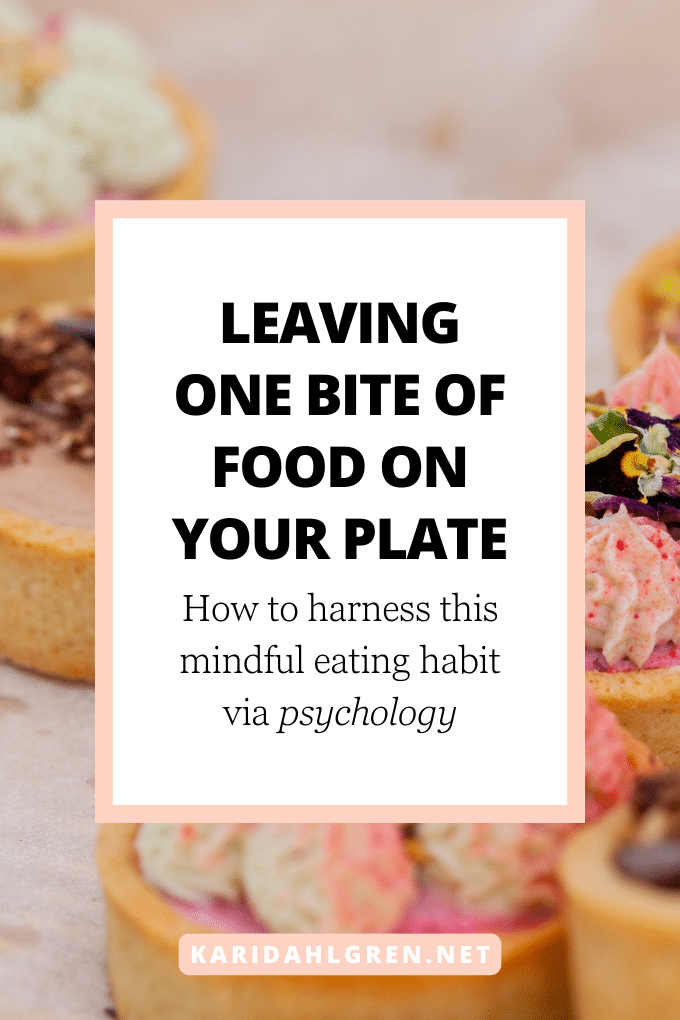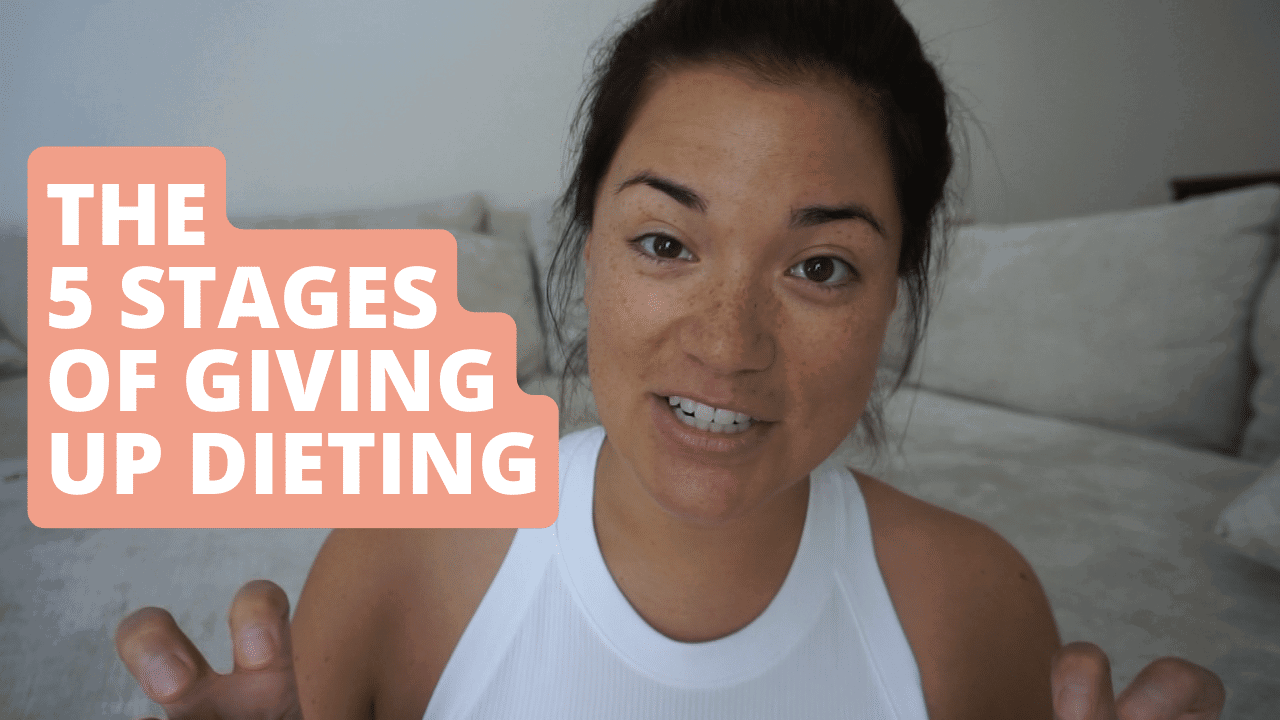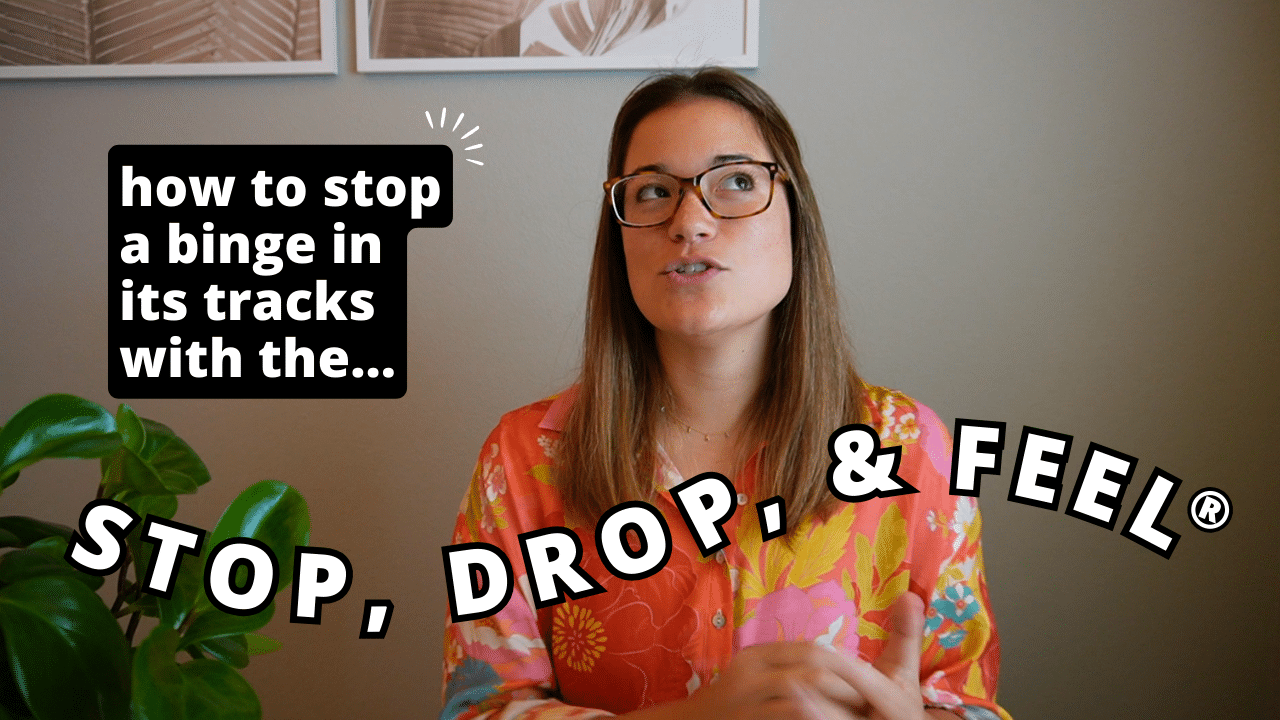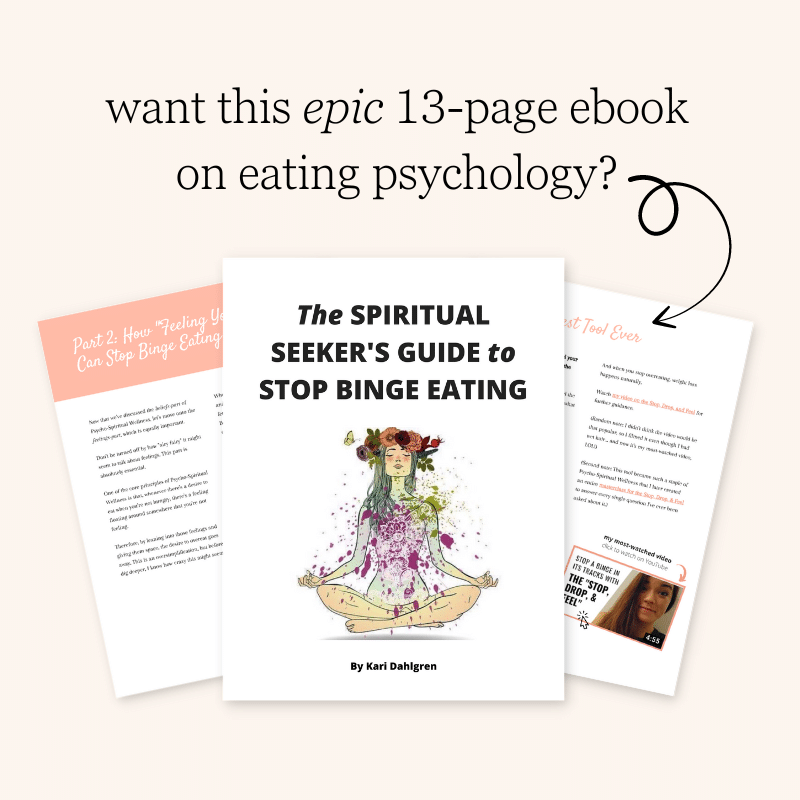
I’ll never forget the first time I had one bite of a brownie and stopped—and though I longed for that ability for many years, I didn’t even realize it! It wasn’t intentional, it’s what naturally happened about a year into my journey giving up dieting and addressing eating psychology instead.
If you’re reading this, perhaps you’re interested in learning how to leave one bite of food on your plate, specifically from a psychological approach. As an eating psychology coach that knows first-hand what compulsive eating is like and the strength it takes to stop, I have plenty of tips to help.
In this post, you’ll learn why it’s normal to struggle with compulsively finishing all the food on your plate and the steps you can take to start leaving one bite of food, or more, behind. At the end, I’ll cover all the benefits of this mindful eating practice.
Why Is It Hard to Leave One Bite of Food Behind?
Leaving one bite of food on your plate can be a symbol of overcoming the compulsion behind compulsive eating, or it can be a mindless habit. For anyone that struggles with compulsive eating, leaving one bite of food behind isn’t a mindless nor a casual occurrence—it’s something we want, perhaps eagerly, but struggle to attain when compulsion is overwhelming.
Here are some common reasons for struggling with leaving one bite of food on your plate:
- Emotional Eating: When emotional eating is involved, it can cause a compulsion to finish all the food on the plate. Interestingly, emotional eating can be driven by both negative and positive emotion, such as finishing all the cake on your plate during a happy celebration or polishing off an entire bag of chips during a stressful time.[1]
- Fear of Food Waste: Many people feel guilty about wasting food, which can stem from lessons learned in childhood or awareness of global hunger issues. This guilt can make it challenging to leave even a small amount of food uneaten.
- Fast Eating: Fast eating can often lead to a reluctance to leave even a single bite of food behind, as it bypasses our body’s natural satiety signals, making it harder to recognize when we’re truly full.
- Food Addiction: Research shows that highly palatable foods (i.e. “junk foods” or “comfort foods” high in fat, carbs, sugar, and/or salt) can affect the brain’s reward circuitry, leading to addictive-like eating behaviors.[2] Food addiction can make it difficult to leave even one bite behind due to intense cravings and a loss of control over eating.
- Binge Eating: Binge eating, characterized by consuming large amounts of food in a short period, can also make it particularly difficult to leave even one bite of food behind, as it also involves a loss of control over eating.
The distinction between food addiction and binge eating disorder is nuanced and highly controversial, with some overlapping behaviors but differing underlying mechanisms.[3], [4] Fortunately, we don’t need to get caught up in semantics.
Anyone that knows first-hand the struggle of compulsive eating knows the bottom line: it’s compulsive, and you can’t “just stop” when someone tells you to. It requires psychological skill-building, which you’re about to learn.
How to Occasionally Leave One Bite of Food Behind
Before we dive in, please know that leaving one bite of food behind on your plate should never come from a place of restraint. Restrained eating is associated with overeating, and it is counterproductive to the goal of healing your relationship with food.[5]
However, if you’re the type of person that struggles with always feeling stuffed after finishing all the food on your plate, then leaving one bite of food behind can help you learn how to stop eating when full—or at least work your way towards that goal.
Here are some steps you can take to work towards an intuitive, mindful relationship with food where leaving one bite of food on your plate becomes accessible:
1. Give Up the Food Rules
To begin the journey of occasionally leaving one bite of food behind, start by giving up restrictive dieting. Restrictive dieting often leads to a cycle of deprivation and overeating, as the ‘forbidden fruit’ effect kicks in—where restriction heightens the desire for the very foods you’re trying to avoid.[6] This can create an emotional charge around eating, making it feel like a high-stakes activity where every bite counts.
By stepping away from dieting and giving yourself permission to eat the foods you love and enjoy—while listening to your hunger and fullness—you can neutralize your relationship with foods so that all foods are equal. Over time, leaving a bite of food on your plate can become a natural byproduct of listening to your fullness and knowing that all your favorite foods will still be there when hunger returns.
2. Prepare for the Stages of Giving Up Dieting

Giving up dieting is not an overnight process; it’s a journey with multiple stages, each presenting its own challenges and opportunities for growth. One of these stages, the Rebellion Binge phase, might make it seem like leaving one bite of food on your plate will never be possible. Trust that as you continue to move along the stages of giving up dieting, a normal relationship with food can emerge—one where you leave one bite of food on your plate without even thinking about it.
3. Address Emotional Eating
We all know that eating can be emotional, and clinical research even backs it up. A low tolerance for discomfort (low “distress tolerance”) is correlated with overeating.[7] When you have low distress tolerance, you’re more likely to turn to food as a way to cope with uncomfortable emotions or situations. This can lead to overeating and a feeling of being out of control around food.
While this is no surprise, what I found interesting is that low distress tolerance is a significant factor in food addiction, challenging the common perception that food addiction is purely neurological.[8] Since food addiction and overeating are both reasons for finishing all the food on your plate—despite feeling full—addressing these issues via emotion regulation skills can help.
4. Develop Emotional Tolerance

This is where my Stop, Drop, & Feel®️ technique comes into play, which applies urge surfing to compulsive eating. Whenever you feel the urge to eat beyond fullness and finish all the food on your plate, pause and promise yourself that you can keep eating after the SDF is over (this honors the element of permission and prevents the SDF from triggering the restrict-binge cycle).
Then, train in sitting still with your emotions for just 2 minutes, which will likely be very uncomfortable and edgy. Fortunately, by training in feeling uncomfortable emotions without resisting them or buffering with food, you can enhance emotional tolerance. Over time, you’ll find that your compulsion to overeat diminishes, and leaving a bite of food behind becomes a more manageable task.
5. Stop People Pleasing
The social aspect of eating can significantly influence our behavior. Clinical studies show that people tend to eat more when they are around others who are eating, a phenomenon known as the social facilitation of eating.[9]
Additionally, there’s often social pressure to clean your plate, especially in situations where you’re a guest or at a social gathering. This pressure can stem from a desire to show respect to the host or to avoid appearing wasteful.
However, it’s important to prioritize your physical health and well-being over social norms and “saving face.” Learning to assert your own needs and boundaries around food can be empowering and can help you make choices that are in alignment with your body’s signals, even if that means leaving a bite of food behind.
Of course, this is easier said than done, and the previous step can help with this. As a recovered people-pleaser myself, I found that building emotional tolerance through the Stop, Drop, & Feel®️ actually carried over into my ability to stick up for myself and stop compulsively pleasing others.
I realized that, in order to stop pleasing others, I had to tolerate the discomfort of gently letting someone down. As my emotional tolerance increased, so did my ability to hold space for the discomfort of protecting my boundaries (e.g. saying ‘no’ when someone tried to push food on me when I wasn’t hungry).
The Benefits of Leaving One Bite of Food on Your Plate
There are many other benefits that you have to look forward to as you learn to eat without compulsion and leave one bite of food behind when it’s what your body is asking for. The Stop, Drop, & Feel®️, while simple, is a demanding and difficult task, and one way to stay motivated is to focus on everything you have to gain.
Here are some of the incredible benefits of learning how to leave one bite of food behind on your plate:
- Enhances Mindful Eating: Leaving one bite of food behind encourages you to pay closer attention to your eating experience, promoting mindfulness. This practice can help you tune into your body’s hunger and fullness cues, leading to more satisfying and enjoyable meals.
- Breaks the Clean Plate Habit: By intentionally leaving a bite of food, you challenge the deeply ingrained habit of finishing everything on your plate. This small act of rebellion can be empowering and help you reclaim control over your eating choices.
- Reduces Overeating: Learning to leave food behind can prevent overeating by allowing you to stop eating when you’re comfortably full, rather than when your plate is empty.
- Increases Awareness of Food Waste: While it might seem counterintuitive, leaving a small amount of food can increase your awareness of food waste and prompt you to be more mindful of portion sizes in the future. It’s a way to honor both your body’s needs and the environment.
- Encourages Intuitive Eating: Leaving one bite of food on your plate—when it feels appropriate for your hunger/fullness cues—aligns with the principles of intuitive eating, which emphasize listening to your body’s signals and eating in a way that feels good physically and emotionally.
These are just some of the benefits of eating mindfully and intuitively, and you’ll likely discover some benefits of your own as you embark on your unique journey.
Leaving One Bite Behind & Never Looking Back
If you’ve always wanted to be able to leave one bite of food behind but struggle with putting it into practice, now you know why: there’s much more that goes into it than meets the eye! For me, it was eating psychology that finally helped me get a handle on compulsive eating and access a relaxed space where I can leave one bite of food behind, or even eat one bite of something sweet and stop.
Many years ago, I thought I’d never be able to get here, so if you feel that self-doubt too, know that a psychology-focused program might be the ticket. My own philosophy, Psycho-Spiritual Wellness, uses the intersection of eating psychology and spirituality to help stop overeating.
To learn more, see my free ebook below and keep your momentum going:




I really really struggle with this. I’ve got to the point where often during a meal I notice that I’ve had enough/I’m satisfied, but then I continue to finish the meal, going against my inner wisdom. I think I’m so focused on not restricting myself, that leaving half a plate feels so wrong. I sometimes get the feeling of what’s the point of leaving a few mouthfuls behind today when you’ll be overeating again soon?…’
Hi Zoe! I think a lot of people can relate to this, myself included. I think it’s a great sign that you are focused on healing your relationship with food. It’s understandable to feel frustrated, and I want to celebrate you for exploring this avenue. To provide some tools, I wonder if you’re going through the stages of giving up dieting, where we pass through the ‘Rebellion’ phase before we can move forward. Does that resonate with you? And if it doesn’t, or if you feel stuck in that stage, it may help to focus on addressing compulsive eating (the desire to continue past fullness) with the Stop, Drop, & Feel. Permission to eat is one pillar of healing your relationship with food, and emotional tolerance is another. I hope these resources help! Let me know if they inspire new questions 🙂